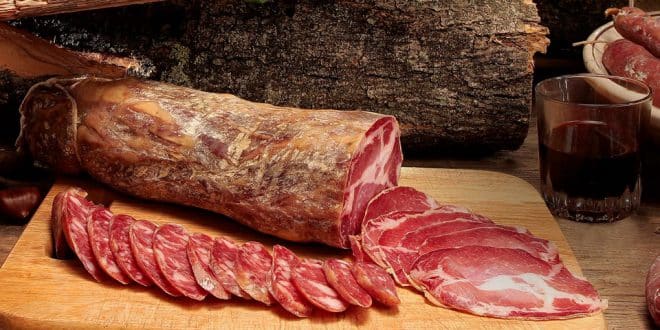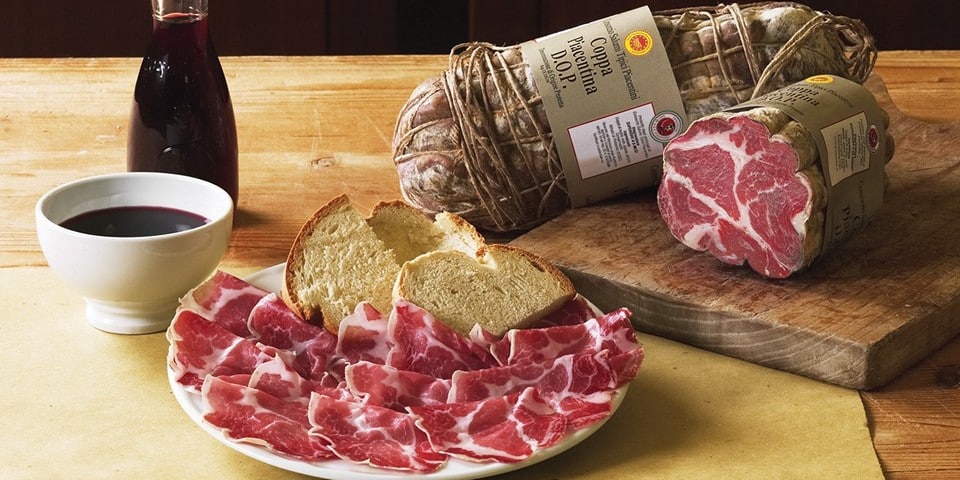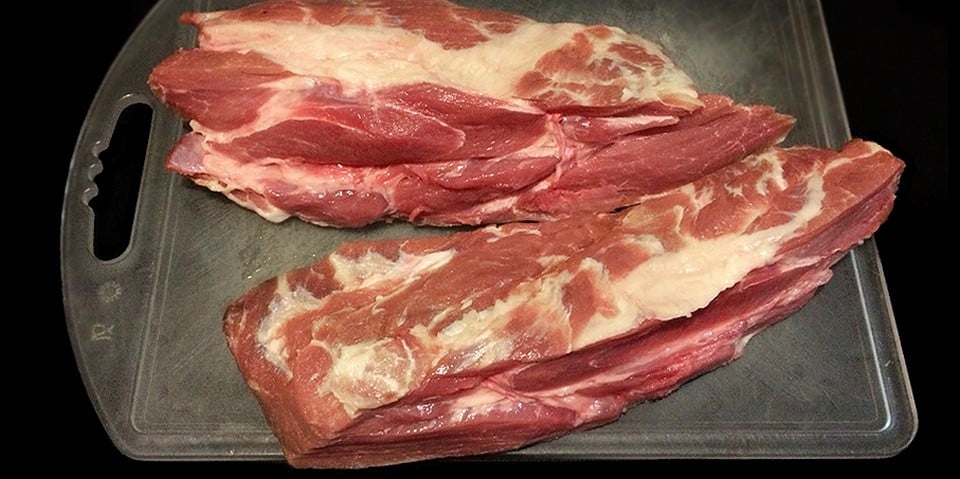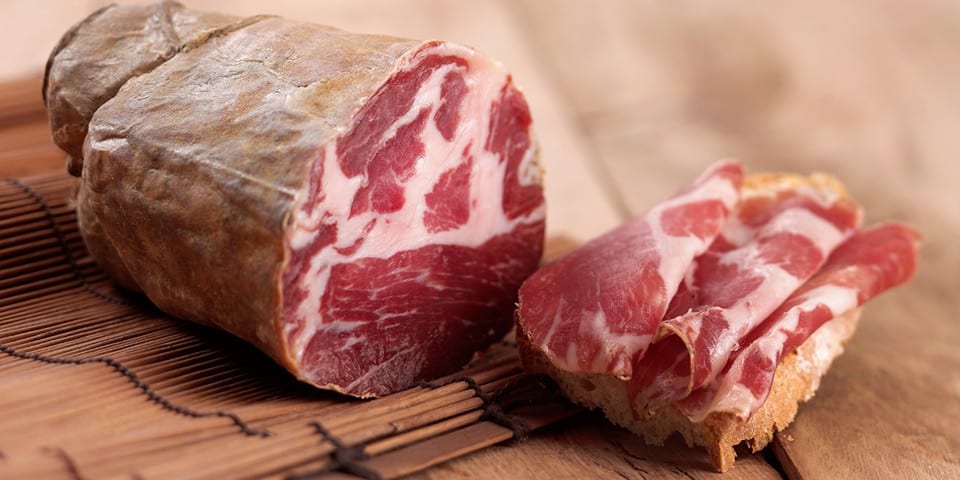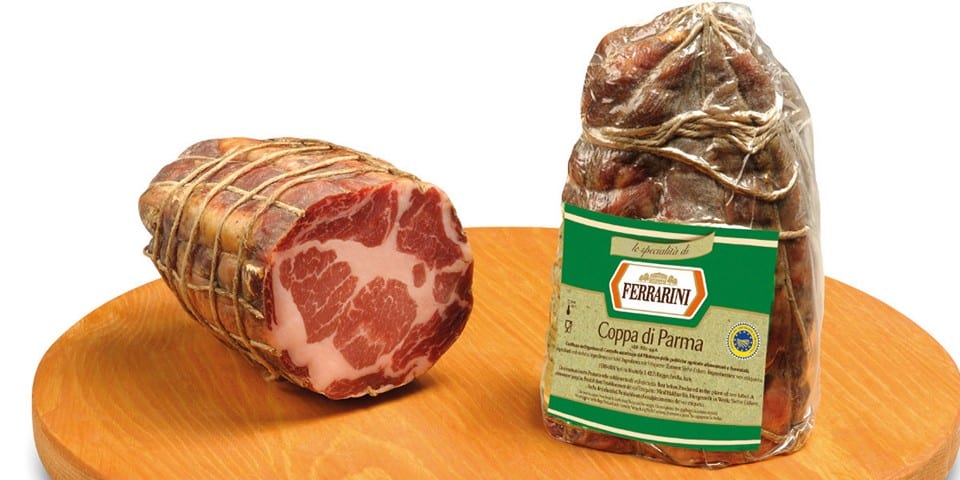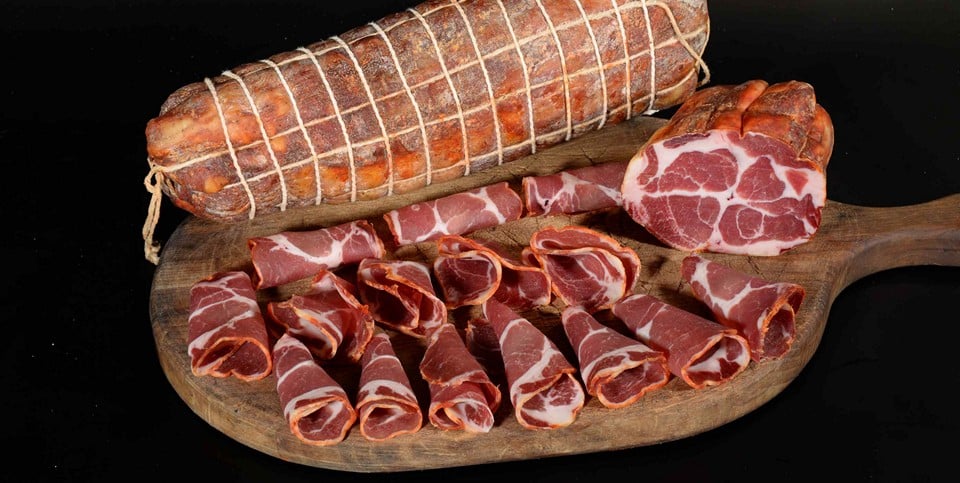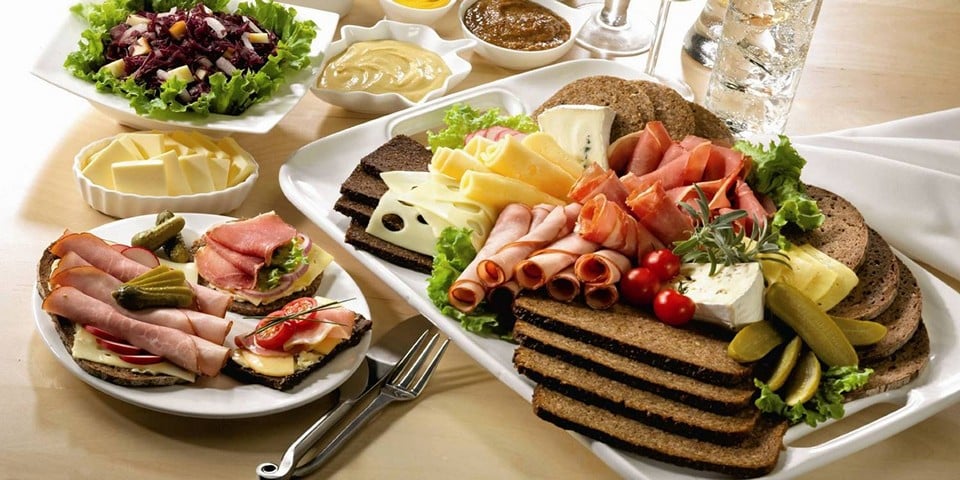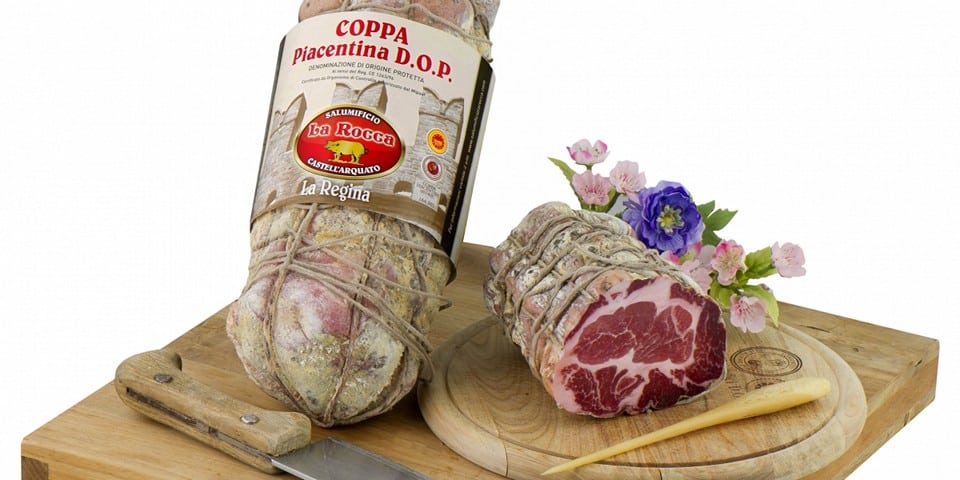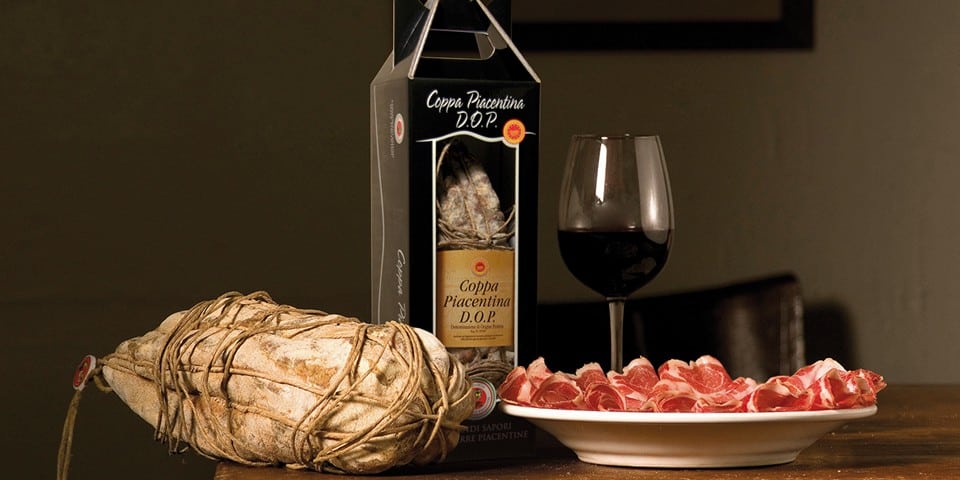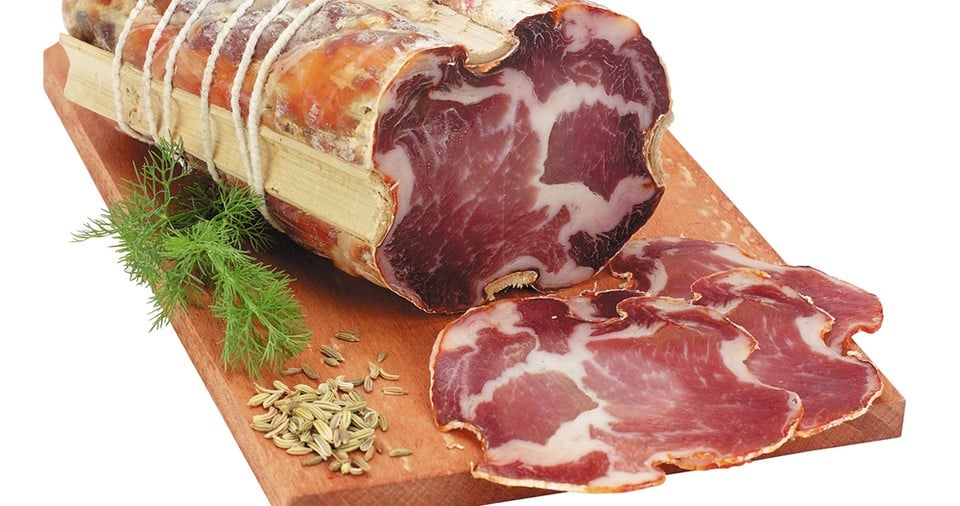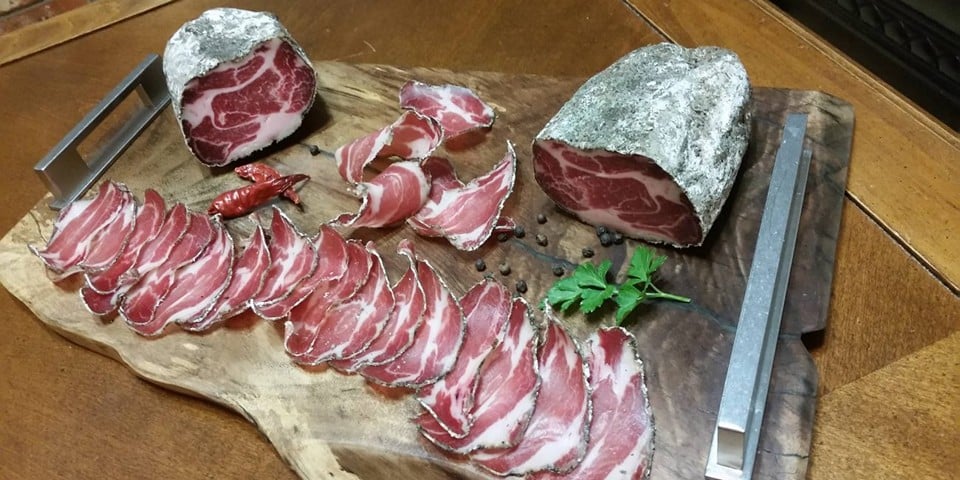In each Italian province, different types of meat are preferred, but cuts from the neck and shoulder of the pig are popular in all regions. They are used to make a traditional product called “Coppa.” The bright red color and marbled white veins on the slice create a truly mesmerizing sight. The spices used in Coppa vary depending on the place of production.
For example, in Piacenza, nutmeg, cinnamon, and cloves dominate, while in Parma, the meat is saltier, and in Calabria, spicy chili pepper is welcomed. Interestingly, the diversity of Coppa is not only in its taste. To uncover all the secrets of this Italian delicacy and learn the recipe for its preparation, our article will help you.
Page Contents
What is Coppa?
Coppa is a traditional Italian product made from meat from the neck and shoulder (up to the 4th or 5th rib) of a pig. It is prepared whole, without grinding, and placed in a natural casing. It resembles prosciutto in appearance, but the production methods have some differences.
The exact origin of Coppa is not fully defined. Although the first documented evidence dates back to the 17th and 18th centuries, historians believe that the preparation of the product has been parallel to pig farming in Italy.
Notably, not only the taste but also the name of the delicacy changes from region to region. In most parts of the country, it is called Coppa or Capocollo. The latter name is a combination of the words “capo” (head) and “collo” (neck).
Regional names sound differently. In Campania, it is known as capicollo, in Tuscany as finocchiata, in Lazio as lonza, and in Marche and Abruzzo as lonzino.
Production
In the first stage of coppa production, the meat is selected and prepared. It is sliced, freed from bones, and carefully separated from the surface fat, with the final thickness of the fat not exceeding 3-4 mm for certain types.
Next comes the seasoning and salting. Some varieties of the product are first rubbed with spices (garlic, various herbs, spices, red or white wine). The choice of spices depends on the region of production. Then the meat is salted, meticulously rubbed as if massaging it. After 4-8 days, the product is rinsed to remove the salt, placed in a natural casing, tied with twine, and sent for aging, the duration of which is regulated for each type.
Varieties
Coppa is valued for its delicate aroma and tender, slightly fatty texture. The taste of the product varies depending on the variety, of which there are quite a few. Despite the wide variety, only 3 types of coppa have the DOP designation, and 1 has the IGP designation. However, it is worth noting that 10 varieties are classified as “Traditional Italian Food Products.” They are:
- Capocollo and Capocollo di Martina Franca from Apulia (Puglia)
- Capocollo from Basilicata, Campania, Molise, and Umbria
- Lonza from Lazio
- Coppa Maccarana from Lombardy (Lombardia)
- Capocollo tipico senese from Tuscany
- Coppa, Lonza, Lonzino from Marche and Abruzzo
Undoubtedly, products with quality designations are considered the best in the market of meat products. Within the family of coppa, these include: Capocollo di Calabria DOP (Capocollo of Calabria), Coppa Piacentina DOP (Coppa of Piacenza), Coppa di Parma IGP (Coppa of Parma).
Coppa di Parma IGP
Coppa di Parma IGP is a cured meat product that is typical of certain regions in Emilia-Romagna and Lombardy. The fresh, unprocessed cut used to make this variety weighs approximately 2.7-3 kg (6-6.6 lbs). The salting process is done using the dry method, where the meat is sprinkled with salt and rubbed thoroughly. Some producers also use pepper, as well as other spices and wine. The future coppa is then placed in a natural casing made from cattle intestines and aged for a minimum of 60 days.
The finished product is regulated to weigh at least 1.3 kg (2.9 lbs) with a length ranging from 25 to 50 cm (9.8 to 19.7 inches). It has a bold, meaty taste, as the absence of excessive spices avoids any foreign additives. The aroma is pleasant and delicate. The texture is medium-dry, without any shine on the surface when sliced. It has a dark red color with rainbow-like veins of fat.

Coppa di Parma is enjoyed as a snack on its own or as part of a meat platter. It is excellent for making sandwiches and pizza. It pairs well with fresh vegetables and greens such as arugula and spinach. The most suitable cheese options are Gorgonzola or any other blue cheese. In Italy, coppa accompanies first courses, such as various bean-based soups. As for alcoholic beverages, it is recommended to choose white wine such as Malvasia DOC or a fragrant, slightly sweet red wine like Bonarda DOC.
Capocollo di Calabria DOP
Capocollo di Calabria DOP is a cured meat product whose entire production process, starting from the rearing of pigs, occurs within the Calabria region. The initial weight of the product ranges from 3.5 to 4.5 kg (7.7 to 9.9 lbs). The salting of the capocollo lasts for 4 to 8 days, after which it is seasoned with black pepper, placed in a casing made from pork diaphragm, and tied with string. The aging process occurs in a natural environment within temperature and humidity-controlled rooms for a minimum of 100 days.
The finished capocollo has a cylindrical shape with rounded ends and a pinkish-red surface. The sliced meat has a pink color with marbled streaks of fat. It has a spicy yet delicate flavor and a medium-intensity aroma.
This delicacy from Calabria pairs well with various products. It can be enjoyed as a snack or used as an ingredient in sandwiches. It enhances the flavors of cheeses such as Caciocavallo and Canestrato. It is also used in dishes like risotto and meat pies. Capocollo di Calabria DOP perfectly accompanies rich red wines like Primitivo di Manduria DOC.
Coppa Piacentina DOP
Coppa Piacentina DOP is a variety of cured meat that is typical of the Piacenza province in Italy. The pork used to make Coppa Piacentina comes from the Emilia-Romagna region and Lombardy, although the processing must take place exclusively within the designated area. The meat is obtained from the neck and trimmed at the height of the 4th rib. The weight of the semi-finished product is at least 2.5 kg (5.5 lbs). A combination of salt and spices such as pepper, cloves, bay leaf, nutmeg, sugar, and cinnamon is used for salting. After one week of the initial process, the product is washed and wrapped in a diaphragm. The aging period lasts for a minimum of 180 days, with the first 7 days spent in a dry and warm room, followed by the remaining period at a temperature of 10-14 degrees Celsius (50-57 degrees Fahrenheit).
The final product, available for sale, has a cylindrical shape with tapered ends. It weighs at least 1.5 kg (3.3 lbs). The texture is compact and not elastic. The sliced meat has a red color with pink-white streaks of fat. It has a sweet aroma and a delicate flavor.
Coppa Piacentina can be enjoyed on its own or combined with various ingredients. It can be used as a cold cut, added to salads, paired with grilled fruits and vegetables, and served with soft cheeses. The recommended wine pairing for Coppa Piacentina is Bonarda dei Colli Piacentini DOC.
Home Recipe
To prepare coppa at home, you need very little time and effort for the preparation steps and about a month of waiting.
Required Ingredients:
- 2 kg pork neck or shoulder;
- 3 kg coarse salt;
- 200 g ground black pepper;
- Spices of your choice (thyme, marjoram, rosemary, garlic, etc.).
Utensils and other necessary helpers:
- A bowl with a capacity of 4-6 liters;
- A small container with a diameter slightly smaller than the bottom of the bowl;
- Parchment paper;
- Confectionery wrapping paper;
- Natural twine.
So, in the first stage, mix the salt with the chosen spices (except for the ground black pepper). Place the overturned small container on the bottom of the bowl. It will prevent contact between the meat and the dripping liquid. Place the pork in the bowl and cover it with the spiced salt. Note that the meat should be completely covered (on top and on the sides).
Leave the preparation in a dry and cool place for a week. During this time, the pork will be salted, lose some of its liquid, and slightly firm up.
To give the future coppa its traditional round shape, rotate it by 45 degrees, sprinkle with salt, and wait for another 2 days.
Remove all the salt from the meat, rinse it thoroughly under running water (you can wipe it with vinegar at the end). Let the semi-finished product dry at room temperature for about an hour and place it on parchment paper. Sprinkle it thoroughly with ground black pepper, massaging it to allow the spice to penetrate the muscle fibers. Wrap the product first with parchment paper, then with confectionery wrapping paper, and secure it with twine.
Hang it in a dry and well-ventilated room for 15 days. If the paper gets wet during this time, it needs to be replaced, and the product should be allowed to mature for another week.
You can store the finished coppa in the refrigerator for several weeks, wrapping it in paper. It is worth noting that the longer the product remains uneaten, the harder it becomes to acquire the qualities of aged meat products.
Caloric Content and Benefits of Coppa
The caloric content of coppa is relatively high – 450 kcal per 100g (2 lbs). The nutritional value of the product is composed of:
- Protein – 20.8g;
- Fat – 40.2g;
- Carbohydrates – 1.4g.
Despite the abundance of fats, there are notable health benefits of this delicacy:
- It is an excellent source of protein, the main building material of the human body.
- A treasure trove of essential microelements: iron (12.5% of the daily norm) – involved in oxygen saturation of cells and metabolism; calcium (2.5% of the daily norm) – forms bone tissue and plays an important role in muscle contraction; phosphorus (37.57% of the daily norm) – a fundamental element of teeth and bones, involved in metabolic processes.
- Rich in vitamins: thiamine (58.33% of the daily norm) – normalizes the functioning of the nervous system and slows down cellular aging; riboflavin (15.38% of the daily norm) – involved in blood formation processes, maintains healthy skin; niacin (37.5% of the daily norm) – prevents cardiovascular pathologies and catalyzes the synthesis of important hormones.
When considering the beneficial properties of coppa, it is important not to forget about the potential harm. Its high content of cholesterol and saturated fatty acids makes it a prohibited product for individuals with hypercholesterolemia and those who are overweight.
Caution should be exercised by individuals with high blood pressure when consuming this delicacy, as it is prepared using a significant amount of salt.
Coppa should be consumed in moderate amounts. To burn off the extra calories from consuming 50 grams of the product, take a 25-minute bike ride or engage in one and a half hours of household cleaning.
Price of Coppa
Italian markets offer a wide range of coppa options. The price for 500 grams of the product varies from 8 to 15 euros, depending on the manufacturer. For example, Capocollo di Calabria DOP costs around 14 euros.
And so, with ease and a wealth of information, we have reached the conclusion of our article. Perhaps it’s time to embark on a journey to Italy for some amazing memories. Don’t hesitate to indulge in these “passionate” delicacies, as the calories gained will quickly dissipate during sightseeing walks.
Interesting Facts about Coppa
- Coppa, also known as capocollo, is a traditional Italian cured pork neck sausage that has been enjoyed for centuries. Its origins can be traced back to Roman times, making it a true culinary heritage.
- The name “coppa” is derived from the Italian word “capo,” which means head, as this delicious sausage is made from the muscle running from the pig’s neck to the fourth or fifth rib.
- To create coppa, the pork neck is carefully trimmed, seasoned with a blend of spices, including black pepper, garlic, and fennel seeds, and then dry-cured for several months. This process imparts a rich and intense flavor to the meat.
- Coppa is known for its marbled appearance and melt-in-your-mouth texture. The generous marbling of fat throughout the meat adds a luxurious and succulent quality to each bite.
- Traditionally, coppa is thinly sliced and enjoyed as an antipasto or charcuterie item. Its delicate flavor pairs well with a variety of accompaniments, such as crusty bread, cheese, olives, and pickles.
- The curing process of coppa allows it to develop complex flavors and enhance its preservation. This makes it a popular choice for picnics, outdoor gatherings and as a convenient ingredient for sandwiches and panini.
- While coppa is typically made from pork, regional variations can be found throughout Italy that use different types of meat, such as wild boar or venison, adding unique characteristics to this beloved cured sausage.
 Italy for me From Italy with love
Italy for me From Italy with love

